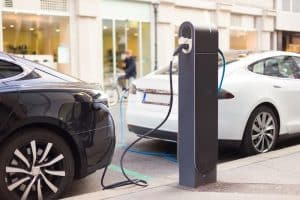
EV Charging Station Technology News
By Sean Houchin, ELATEC
Intro
The electric vehicle (EV) charging market is growing at lightning speed, both in the U.S. and globally. As both consumers and government and commercial fleets transition to electric, membership-based charging stations are popping up in employee parking lots, tenant parking garages and public areas. Many of these EV charging stations rely on RFID and smartphone-based BLE or NFC credentialing for member authentication. RFID cards and mobile apps are simple and convenient for tenants, employees and members. Here are six questions charging network managers and charging equipment manufacturers should ask before implementing an RFID reader solution.
What wireless technologies does the reader need to support?
Are your end-users likely to use a smartphone to access charging services or a membership card? Or will you need to accommodate both options? More than 60 RFID transponder technologies are in common use worldwide, including low-frequency (125 kHz) and high-frequency (13.56 MHz) technologies. Smartphones typically use Bluetooth® Low Energy (BLE) or Near-field Communication (NFC) to communicate with the reader. If you are issuing your own membership cards used across your entire network, you may have a lot of control over the technologies used. But if your network supports government or commercial fleet customers, multi-tenant buildings or similar user communities, it may be preferable to allow users to tap in with an existing company or building ID card. A multi-technology reader that supports both HF and LF RFID and BLE and NFC provides the greatest flexibility to meet the needs of users, now and in the future.
How easy is it to update the readers?
Firmware for RFID readers will need to be updated periodically to address emerging security vulnerabilities, introduce new functionality or add new transponder technologies. EV charging networks are, by nature, widely distributed geographically. Physically visiting each charging unit to update or change out the RFID reader is a daunting task. Look for an RFID reader that can be easily updated with a contactless card or, even better, remotely over a network. Remote configuration enables network managers to update firmware for all installed readers at EV charging stations simultaneously.
Is the RFID reader certified in all of the areas in which charging stations will operate?
Increasingly, EV charging networks cross-national boundaries. Most RFID readers are only certified for sale and use in a limited number of countries. If you’re managing a global network of EV chargers—or plan to take your network global in the future—it’s essential to have a reader that is certified for use in all of the regions in which you intend to operate. Having a single reader that can be used internationally simplifies implementation and management of your reader network and ensures that card or smartphone technologies are compatible at all stations in the network.
Does the RFID reader support security requirements for EV charging?
EV charging stations need a secure user authentication method that cannot be easily hacked or compromised to reduce the potential for fraudulent use. This is especially important if the user authorization connects to a billing system that tracks charging station use. The reader should support advanced encryption to reduce the risk of card cloning or data interception. Make sure it provides secure storage for encryption keys so they cannot be compromised. And look for a customizable API to support evolving security requirements.
Does the reader software support functionality requirements for EV charging?
For EV charging applications, the RFID reader must be able to integrate with backend systems that authenticate membership and track usage for billing or cost allocation purposes. It may also be desirable to customize reader functionality for a better user experience, such as activating LED lights to provide visual cues for users. The software for the reader should be robust and flexible enough to customize and support all of the functionality that might be needed.
Can the reader be easily integrated into the form factor of the charging unit?
Consideration must also be given to how the reader will be physically integrated with the charging unit. Does it have the appropriate hardware interfaces to connect to the unit? Is it small enough to be embedded inside the unit, or would it have to be attached to the outside? If it will be attached, is the reader housing tamper-proof and suitable for exposure to the elements? Embedding the reader into the charging unit is best for both security and weatherproofing. Look for a reader that can be embedded without making significant modifications to the design of the unit.
Interested in learning more about technical considerations for RFID in EV charging?
Download 11 Considerations for RFID Readers in EV Charging for additional advice, including operating power and consumption requirements, antenna placement, hardware communication interfaces and more.
Sean Houchin is the product manager for ELATEC Inc in Palm City, Florida and part of the global ELATEC GmbH product management team. He has more than 20 years of experience in product development, management and applications engineering. Sean is an expert in RFID technology, optoelectronic and fiber optic video, audio, and data transmission equipment for military and commercial applications and is a veteran of the United States Navy.
Related Articles
- EV Charging ADA Considerations – a Kiosk Perspective
- https://kma.global/ada-faq/
- Kiosk Software Adds RFID Devices for Bluetooth NFC Kiosks – Elatec and KioWare
- Kiosk RFID News – Elatec U.S. Production Facility Ships First 100,000 RFID Units
- New mobile specific touchless mobile interaction RFID Readers ELATEC





